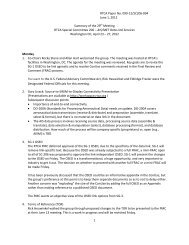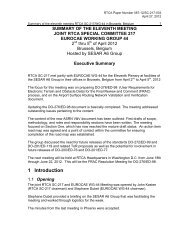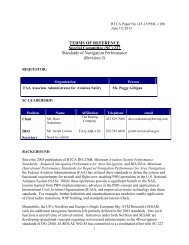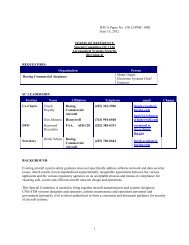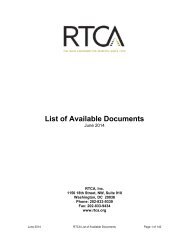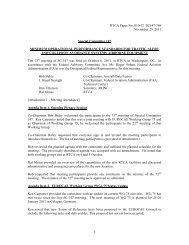SC-226 MEETING MINUTES Working Group JANUARY 14 ... - RTCA
SC-226 MEETING MINUTES Working Group JANUARY 14 ... - RTCA
SC-226 MEETING MINUTES Working Group JANUARY 14 ... - RTCA
Create successful ePaper yourself
Turn your PDF publications into a flip-book with our unique Google optimized e-Paper software.
<strong>RTCA</strong> Paper No. 021-13/<strong>SC</strong><strong>226</strong>-010<br />
February 6, 2013<br />
For Radiated Susceptibility: The level shall be 2 V/m at the frequency range<br />
specified within the applicable category in DO-160x.<br />
Note: DO-307 covers Radiated RF Interference considerations for<br />
Transmitting Portable Electronic Devices (PEDs). RF Interference from PEDs<br />
devices can interfere with functions of the audio system. Audio System<br />
components are only exposed to PEDs RF Interference when the Audio System<br />
component is located in an area of the aircraft near the PEDs devices and when<br />
there is no metal shielding between the audio system component and the PEDs<br />
devices. As a result, it is reasonable for only the exposed audio equipment to be<br />
tested according to the requirements of DO-307. Additionally, when equipment<br />
is mounted so that a portion of the equipment is shielded, it is reasonable for<br />
only the exposed side(s) of the audio equipment to be exposed during the PEDs<br />
RF Interference testing. An analysis should be used to describe the rationale<br />
for the manner in which the equipment under test is exposed.<br />
Discussion of problems experienced by members of the committee with regard to current test<br />
requirements calling for the conducted RF frequency sweep to start at 10KHz.<br />
Experience of the participants has found that even when the 10KHz RF signal is applied with no<br />
modulation, it can often be heard over the audio system. 10KHz is very close to the audio frequency<br />
band of interest for the audio system. The audio system is typically composed of a large number audio<br />
inputs and outputs, all of which must be filtered to remove RF. However, with the RF starting<br />
frequency so close to the audio frequency band, the filters must be more effective, more complex,<br />
require more components, and occupy more space within the equipment enclosure in order to be<br />
effective enough to remove 10 KHz RF noise. As a practical matter, such a design will be<br />
mathematically less reliable, and the committee questions why the RF frequency should start at such a<br />
low frequency when there are no sources of this type on board the aircraft. The consensus was that<br />
the starting frequency should start at a frequency just beyond the maximum audio frequency band<br />
discernible by human hearing (e.g. >20 KHz). 24 KHz was chosen as the new starting frequency. The<br />
language in the standard was edited as follows for conducted RF susceptibility testing.<br />
For Conducted Susceptibility: The level shall be 3 mA (2 V/m) from 500 kHz to<br />
400 MHz, and from 500 kHz to 24 kHz shall fall at the rate of 6 dB per octave (20 dB per<br />
decade).<br />
Don Nault, Boeing took the action to check with his compliance personnel at Boeing to determine if the note is<br />
acceptable.<br />
Discussion on fire protection. TSO-C57a and TSO-C58a used to include a requirement similar to as follows from<br />
DO-2<strong>14</strong> but no longer do and this sometimes causes problems for Boeing when equipment is not tested to Part 25<br />
Appendix F.<br />
2.1.4 Fire Protection<br />
Page 15 of 20




